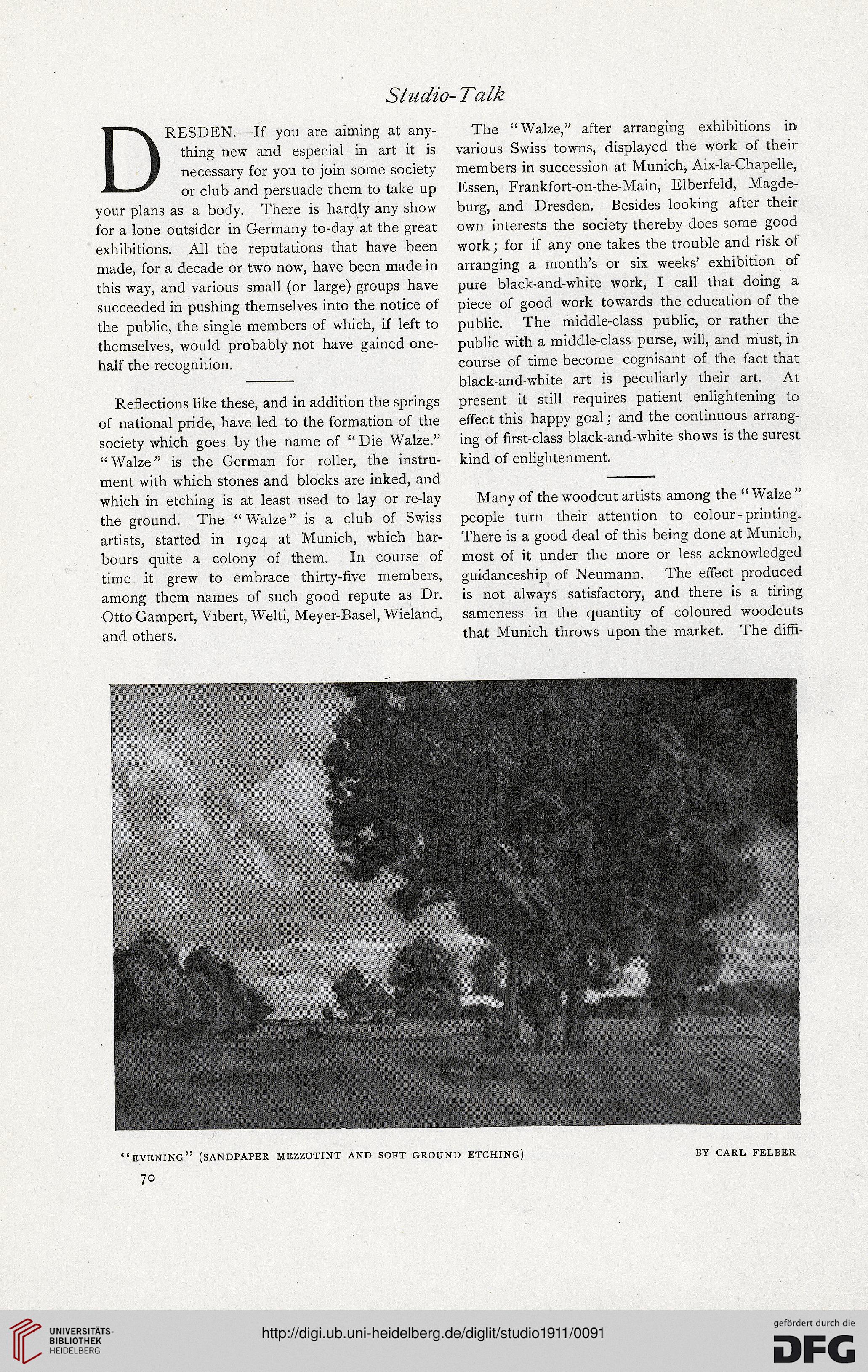Studio-Talk
DRESDEN.—If you are aiming at any-
thing new and especial in art it is
necessary for you to join some society
or club and persuade them to take up
your plans as a body. There is hardly any show
for a lone outsider in Germany to-day at the great
exhibitions. All the reputations that have been
made, for a decade or two now, have been made in
this way, and various small (or large) groups have
succeeded in pushing themselves into the notice of
the public, the single members of which, if left to
themselves, would probably not have gained one-
half the recognition.
Reflections like these, and in addition the springs
of national pride, have led to the formation of the
society which goes by the name of “ Die Walze.”
“ Walze ” is the German for roller, the instru-
ment with which stones and blocks are inked, and
which in etching is at least used to lay or re-lay
the ground. The “Walze” is a club of Swiss
artists, started in 1904 at Munich, which har-
bours quite a colony of them. In course of
time it grew to embrace thirty-five members,
among them names of such good repute as Dr.
■Otto Gampert, Yibert, Welti, Meyer-Basel, Wieland,
and others.
The “Walze,” after arranging exhibitions in
various Swiss towns, displayed the work of their
members in succession at Munich, Aix-la-Chapelle,
Essen, Frankfort-on-the-Main, Elberfeld, Magde-
burg, and Dresden. Besides looking after their
own interests the society thereby does some good
work; for if any one takes the trouble and risk of
arranging a month’s or six weeks’ exhibition of
pure black-and-white work, I call that doing a
piece of good work towards the education of the
public. The middle-class public, or rather the
public with a middle-class purse, will, and must, in
course of time become cognisant of the fact that
black-and-white art is peculiarly their art. At
present it still requires patient enlightening to
effect this happy goal; and the continuous arrang-
ing of first-class black-and-white shows is the surest
kind of enlightenment.
Many of the woodcut artists among the “ Walze ”
people turn their attention to colour-printing.
There is a good deal of this being done at Munich,
most of it under the more or less acknowledged
guidanceship of Neumann. The effect produced
is not always satisfactory, and there is a tiring
sameness in the quantity of coloured woodcuts
that Munich throws upon the market. The diffi-
“evening” (sandpaper mezzotint and soft ground etching)
70
BY CARL FELBER
DRESDEN.—If you are aiming at any-
thing new and especial in art it is
necessary for you to join some society
or club and persuade them to take up
your plans as a body. There is hardly any show
for a lone outsider in Germany to-day at the great
exhibitions. All the reputations that have been
made, for a decade or two now, have been made in
this way, and various small (or large) groups have
succeeded in pushing themselves into the notice of
the public, the single members of which, if left to
themselves, would probably not have gained one-
half the recognition.
Reflections like these, and in addition the springs
of national pride, have led to the formation of the
society which goes by the name of “ Die Walze.”
“ Walze ” is the German for roller, the instru-
ment with which stones and blocks are inked, and
which in etching is at least used to lay or re-lay
the ground. The “Walze” is a club of Swiss
artists, started in 1904 at Munich, which har-
bours quite a colony of them. In course of
time it grew to embrace thirty-five members,
among them names of such good repute as Dr.
■Otto Gampert, Yibert, Welti, Meyer-Basel, Wieland,
and others.
The “Walze,” after arranging exhibitions in
various Swiss towns, displayed the work of their
members in succession at Munich, Aix-la-Chapelle,
Essen, Frankfort-on-the-Main, Elberfeld, Magde-
burg, and Dresden. Besides looking after their
own interests the society thereby does some good
work; for if any one takes the trouble and risk of
arranging a month’s or six weeks’ exhibition of
pure black-and-white work, I call that doing a
piece of good work towards the education of the
public. The middle-class public, or rather the
public with a middle-class purse, will, and must, in
course of time become cognisant of the fact that
black-and-white art is peculiarly their art. At
present it still requires patient enlightening to
effect this happy goal; and the continuous arrang-
ing of first-class black-and-white shows is the surest
kind of enlightenment.
Many of the woodcut artists among the “ Walze ”
people turn their attention to colour-printing.
There is a good deal of this being done at Munich,
most of it under the more or less acknowledged
guidanceship of Neumann. The effect produced
is not always satisfactory, and there is a tiring
sameness in the quantity of coloured woodcuts
that Munich throws upon the market. The diffi-
“evening” (sandpaper mezzotint and soft ground etching)
70
BY CARL FELBER




